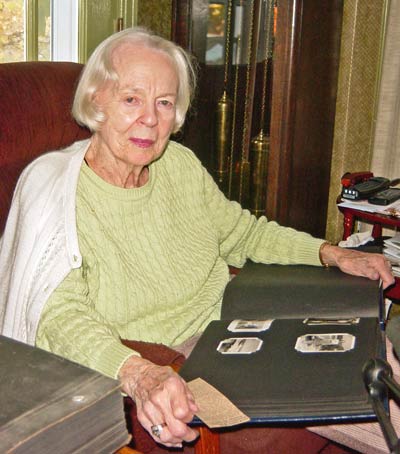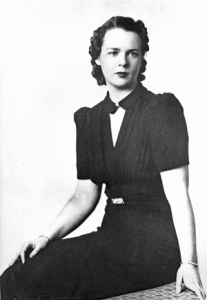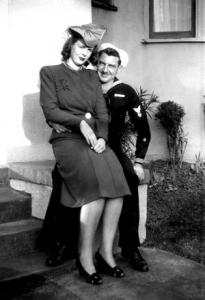Pioneer Profiles – October 2014
This month I’m taking a break from the ongoing series of stories about 19th Century life in Jacksonville to pay tribute to a special person—Georgia Curran Scott Lind. On August 20, 2014, Jacksonville lost this 20th Century pioneer three weeks short of her 96th birthday. Georgia experienced almost all of the major 20th Century events and participated in the changing roles for women along the way. This story is based on a 2008 interview with Georgia that appeared in a Jacksonville Review Living History series.
Georgia Curran was born a “snub-nosed Irish kid” in 1918 in Berkeley, California. She never knew her father, Walter Curran. He was killed in France during World War I when she was six-weeks-old.
The family moved to Seattle on Georgia’s seventh birthday. “The whole family piled into my uncle’s big Dodge touring car. There were three people in the front seat, and four in the back seat along with our canary, the birdcage, and my birthday cake.”
After finishing high school, Georgia enrolled at the University of Washington, graduating with a major in nutrition. She considered becoming a hospital dietician until learning she would have to live in a hospital for a year. Instead she enrolled in the University’s commercial dietetics program, interning in dorms, a tea room, a hotel, and the University Commons. For her final project, managing a food service operation, she ran the cafeteria at American Cannery.
Georgia returned to California following graduation. It was the Great Depression, and she was fortunate to obtain a job with the Work Projects Administration, established by Franklin D. Roosevelt in 1935 to provide employment. Georgia taught kitchen skills in a program that trained unskilled women as caretakers.
“The women came for training once a week and we went to their job sites once a week. Things were so tight during the Depression that people would share living quarters, share cars, etc. You slept wherever you could flop.” She remembered one site visit where she had to step over sleeping bodies to get to the kitchen.
Georgia recalled people standing on street corners selling apples and pencils and coming to the back door asking for handouts. She remembered the Veterans’ March on Washington following President Herbert Hoover’s 1932 veto of legislation that would have paid a portion of the bonuses promised World War I veterans. The resulting protests—and the government’s response—led to the destruction of Hoover’s humanitarian reputation and any hopes for his reelection.
“Then the Japanese bombed Pearl Harbor. We were working when FDR came on the radio. It was really the War that ended the Depression. After that we got into rationing. There were black outs—you had to drive with the lights off. My grandmother dug up her roses and planted a ‘Victory Garden.’”
Georgia applied for a food inspector position with the Federal Department of Agriculture. “You had to be able to drive and to lift 25 pounds. You couldn’t be color blind because some grading was based on color. And you couldn’t smoke because that could interfere with your sense of smell.” For the remainder of World War II, Georgia worked as a processed foods inspector for the FDA.
Georgia was inspecting a dried fruit place on the day the War ended. “Word got out early and everyone started having drinks. Everyone got so ‘happy’ that they sent us all home.”
Georgia had met her first husband, Ed Scott, before the War. “He was a marine welder in the shipyards, so when he was inducted, the Seabees claimed him. He built marine bases in Scotland and England before the invasion of Europe.” Ed was home on a 30-day leave when the couple married—“Armistice Day, November 11, at 11 o’clock in the morning.”
After the War, Ed attended the University of California, Berkeley. However, the GI Bill only paid $105 a month. The couple couldn’t live on that amount, so Georgia went to work for the Berkeley school system as home economist for their childcare centers, nutritionist for summer school, and pediatric assistant in their ‘well baby clinics.’
After Ed graduated from the university with a degree in forestry, the couple moved to Humboldt County where Ed worked for a lumber mill. The schools didn’t have any such thing as a nutritionist or a home economist, so Georgia went to the local employment office. They had an opening for a social worker, so Georgia became a social worker.
Georgia worked in the General Relief and the Aid to Needy Children (ANC) departments. “This was before Social Security. When people ran out of money, they wound up on General Relief. It was an eye-opening experience.” Based on her school visits, Georgia felt the ANC children were being ignored, so she returned to school to become a teacher.
With her teaching certificate, Georgia got a job as a Home Ec teacher—“the boys’ Home Ec! Then they decided they needed someone to work with slow learners.” Georgia found herself teaching English and geography to kids who were dyslexic, mentally challenged, and emotionally challenged.
So Georgia became interested in counseling. However, work as a counselor required a general secondary credential, and she again returned to the University. A department head arranged her coursework so that she obtained her secondary teaching credential, her state counseling and guidance credential, and her MA in educational psychology. From then on, Georgia was a counselor.
But by the summer of 1969, the economy in Arcata was not good. On a fluke, Georgia applied for jobs in the Medford area, and Central Point hired her. Georgia and Ed packed up and moved into an old two room miner’s shack that they owned in the Applegate, and Georgia began her career as a counselor at Central Point High School.
She describes their first winter. “It was rough. We had bought our Applegate property as a summer place for Ed to hunt and fish. The shack had no insulation, and it was so cold we even allowed the animals in the house. There was electricity and running water in the kitchen, but there was no bathroom—just the outhouse.”
For years, the couple had been coming to Jacksonville to visit a friend, Ruth Preston. “The town was all boarded up. There was a mercantile store that sold all kinds of things—like a ten cents store—plus liquor, and fishing and hunting licenses. At one time Jacksonville had been a boom town, but when the railroad ran through Medford it became ‘the other side of the tracks.’ Ruth had moved here because of the history—and the cheaper rents.”
Georgia remembers the town’s initial preservation efforts after the Oregon Department of Transportation proposed to raze 11 historical structures for a highway. “They were going to put a road through and dig up the old railroad tracks. Tony Netboy and John Witteveen lay down in the street in protest. Then Robbie Collins got the Preservation Society to come hold workshops in the U.S. Hotel.”
Soon afterwards, Ruth Preston decided to move back to Medford and offered to sell them her house for $10,000 under the listing price. Ruth owned the John Bilger house, built by a prominent Jacksonville tinsmith and hardware store owner in the 1860s.
Georgia and Ed and talked about it for about 30 minutes. He said, “We can’t afford not to!” They moved in just before Christmas 1970.
The house also had a contemporary history. “Britt was hatched in the backyard when Ruth lived there. Somehow Britt got permission to use the hill. They had a wooden platform with tin can lights and a tarp over the musicians. When it was raining, they would move the concert to the U.S. Hotel.”
Georgia became friends with John Trudeau, Britt’s founder and first conductor. “John rented our house for two summers while we went to our Applegate cabin, and he would go fishing with Ed.”
She was also an early member of the Britt Society. “For the first five years, early in summer we would grub out all the poison oak and ivy and weeds on the Hill to make it usable. Our big fundraiser was a huge antique show at the Old School.”
Ruth also introduced Georgia to the newly formed Jacksonville Boosters Club. “We got stones from the old quarry and paved around Old City Hall. We repaired the stone wall along Cemetery Road. And we worked on the Sexton’s Tool House—that’s when we discovered the underground vault where bodies were stored until they could be buried.”
Georgia also served on a commission that studied the treatment of juvenile offenders, resulting in today’s alternative schools and community service projects. She served for five years on a board that was a predecessor of CASA. And she served as a Jacksonville Planning Commissioner.
Georgia resigned from the Planning Commission in 1985 when her husband Ed became ill and died. They had been married for forty years.
And so began Georgia’s years as a world traveler. She made two or three trips a year, touring the British Isles, much of Europe, and most of Central and South America, Africa, and Asia.
She met her second husband, Chester Lind, in New Zealand on a bus. “One of the couples in our tour group was talking, and this man tapped them on the shoulder and asked if they were talking about the Rogue Valley. He said he had grown up in the Applegate and attended Jacksonville High School. His mother was a Kubli and still lived on their Century Farm in the Applegate.”
Georgia and Chester were married in 1987, but eight months later Chester died following a botched surgery.
In 2002, a stroke slowed Georgia down physically, but she continued her community involvement. She remained active in a book club and the Jacksonville Garden Club, and she was a member of the American Association of University Women for 55 years.
She was also a member of collectors’ clubs and owned an extensive collection of specialty glass. She recalled always liking glass. “My grandfather collected cut glass, which I didn’t understand until I learned about the Irish ‘social ladder’—‘shanty Irish,’ ‘lace curtain Irish,’ and finally ‘cut glass Irish.’ If you were cut glass Irish, you were finally at the top.”
Georgia Curran Scott Lind was definitely “cut glass Irish.”


